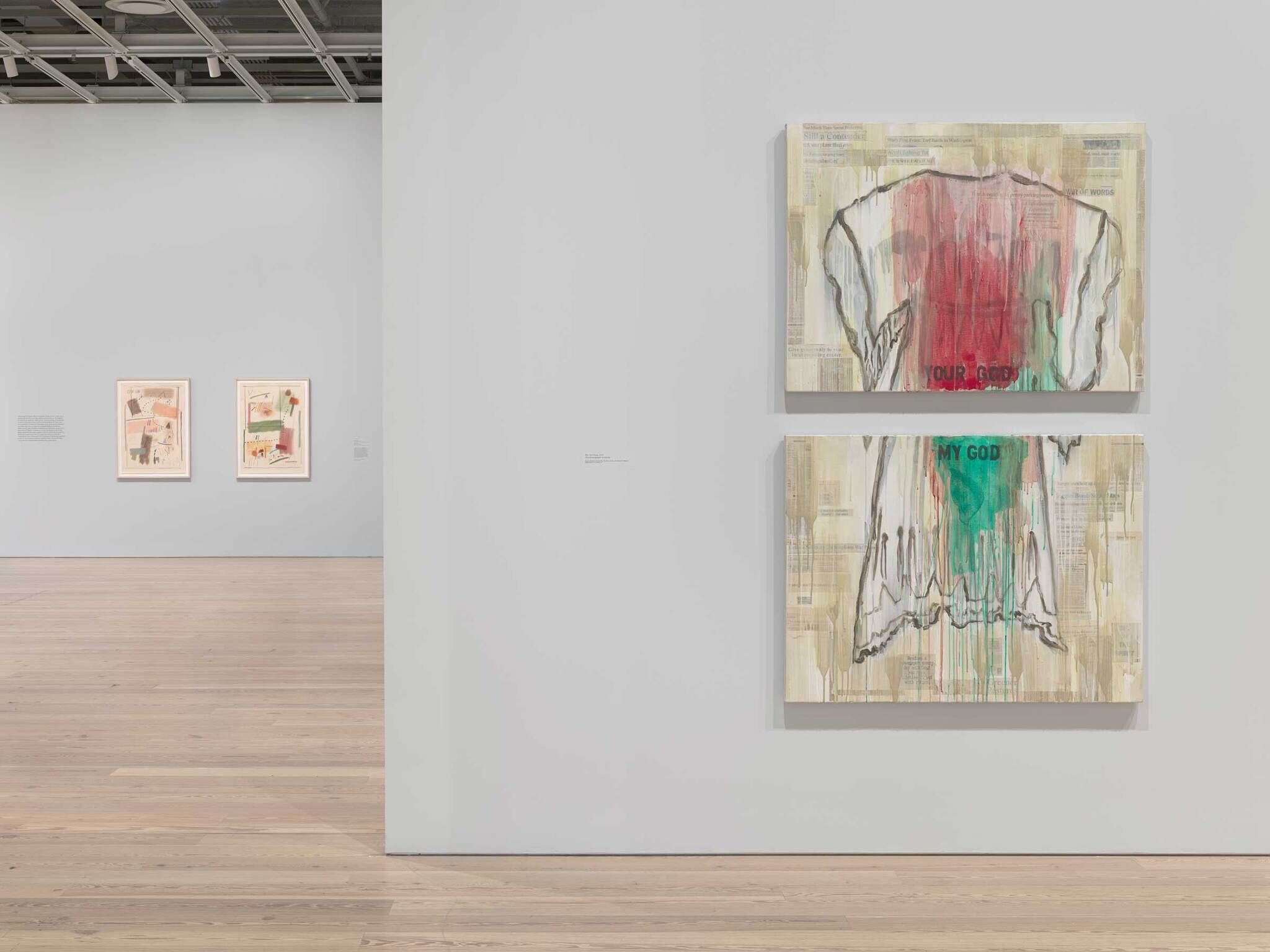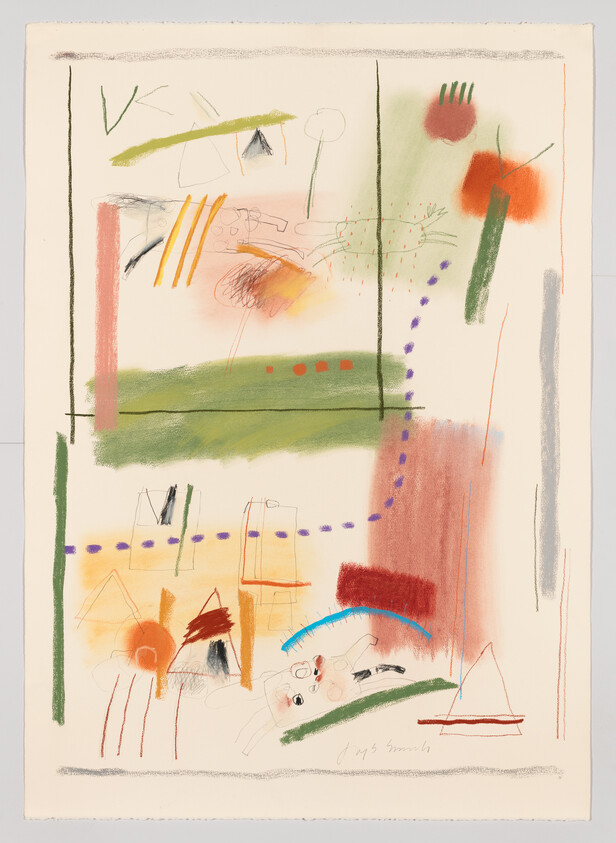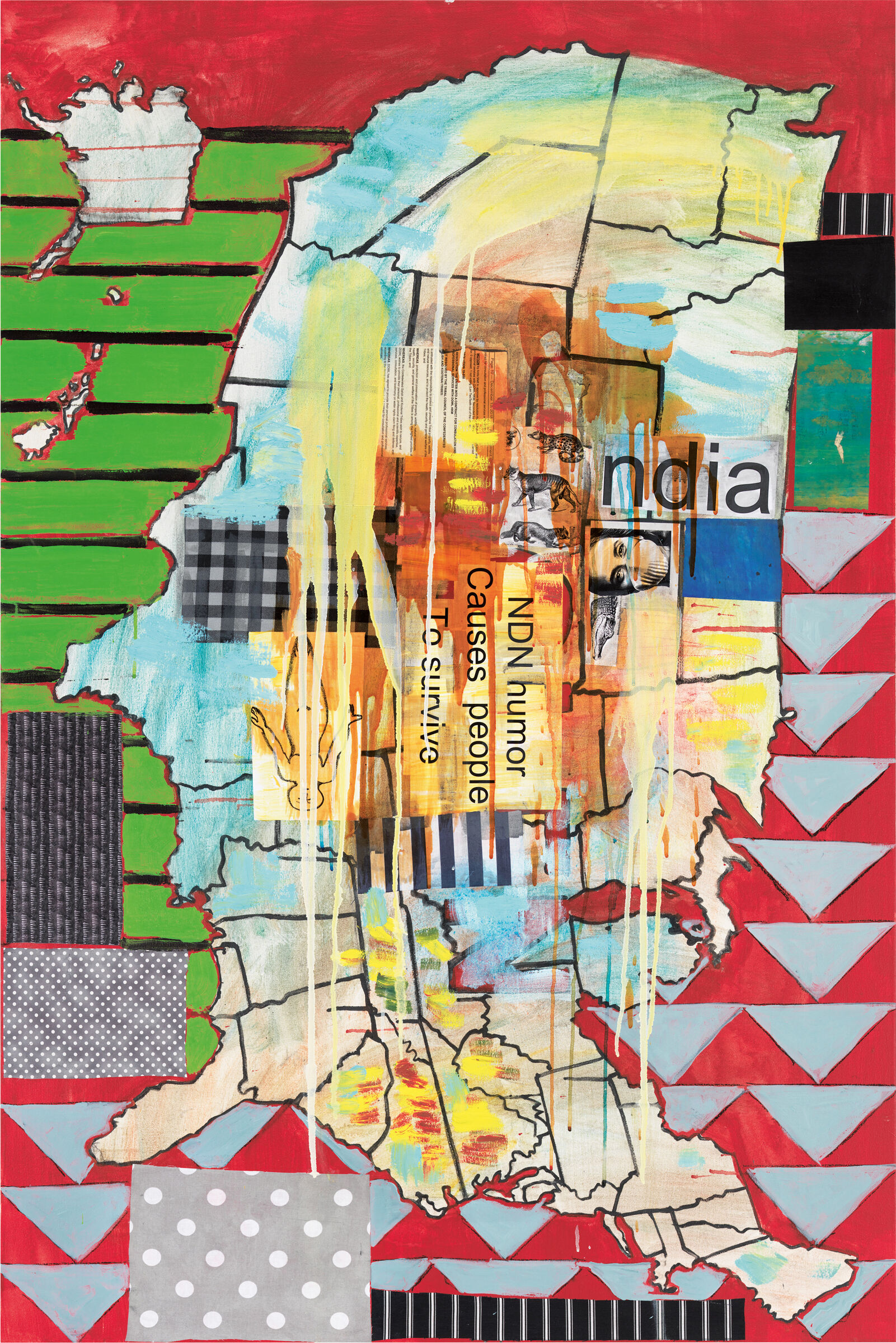Visual description
Kalispell #1 is a vertical pastel and charcoal drawing on paper, 41 3/4 inches high by 29 5/8 inches wide. The paper is a beige color with both abstract and abstract and colorful marks often related to animal, human or natural themes. Several thick and thin lines of gray, brown, black and green create a vertical rectangle by the edges of the paper outlining the image. This composition appears like frames within frames. In the upper left corner of this rectangle, black lines create another vertical rectangle that takes up a bit more than one quarter of the space. There are a few large, washy rectangular shapes throughout the composition that the artist would have drawn first before layering the thinner pictorial drawings on top. In the middle of the work, slightly off-center to the left, is a green horizontal rectangle shape made from at least two green pastel houses. Hanging down vertically off that green rectangle’s lower right edge is a light pink rectangle about the same size. In the lower left quadrant, there is a whisper of yellow in the shape of another horizontal rectangle. And in the upper right quadrant there is a very faint green vertical patch. The greens, pinks, and yellows echo and repeat in other lines and marks throughout the work, creating a visual cohesion. There are only two marks whose colors do not repeat: one is a dotted purple line that travels in an L-shape from the upper right quadrant to the mid-lower left part of the page. The other is a slim blue arc shape in the middle/bottom area. The hue of the blue is vivid and brilliant, in contrast to the mellow, earthy tones of most of the shapes and lines.
The colors, taken together with the composition, suggest a kind of cartography or charting of the natural environment. The thinnest lines in this drawing are the least abstract ones, and if we inspect them, they reveal triangular tipis and animal shapes. Centered at the bottom of the image is an abstracted animal with a thin black outline, a boxy spotted body, and rounded tail. The animal leaps over a thick stroke of green and above it is a curved stroke of blue with thin brown and blue lines intersecting the blue curve. To the right of this animal, there are thick vertical yellow lines on either side of a tipi outline, with a charcoal-drawn entrance. In the upper left frame mentioned before, there are two, four-legged animals drawn with loose and very thin simple lines. The left animal is drawn with black lines and appears similar to a horse with a long neck and a boxy body and face. There is a faint wash of light pink behind it. It has a sketchy tail, and its body has several circular spots. Three yellow diagonal lines overlap its body. The animal on the right is drawn with green lines and has a long round body and tail. It has thin pointy legs and a small pointed face with an open mouth, and across its body are rows of orange dots reminiscent of falling rain. The animals leap over a cluster of brown scribble-like loops smudged with yellow above a thick horizontal patch of green with a row of four small orange dots, and behind them is a long vertical stroke of pink.
Above the animals are triangular shapes, a swipe of green, two short horizontal lines, and a circle with a line coming down from inside the middle of the circle. The artist signs her name small and in cursive at the bottom of the image in between the leaping animal, triangle and a gray horizontal line that frames the image.
Kalispell, the title of the work, is the name of a city just north of the reservation of the Confederated Salish and Kootenai, where Quick-to-See Smith grew up.
Not on view
Date
1979
Classification
Drawings
Medium
Pastel and charcoal on paper
Dimensions
41 3/4 × 29 5/8 in. (106 × 75.2 cm)
Accession number
2008.137
Series
"Kalispell Series"
Credit line
Gift of Altria Group, Inc.
Rights and reproductions
Courtesy the artist and the Garth Greenan Gallery, New York
Audio
-
0:00
Verbal Description: Kalispell #1, 1979
0:00
Narrator: Kalispell #1 is a vertical pastel and charcoal drawing on paper, 41 3/4 inches high by 29 5/8 inches wide. The paper is a beige color with both abstract and abstract and colorful marks often related to animal, human or natural themes. Several thick and thin lines of gray, brown, black and green create a vertical rectangle by the edges of the paper outlining the image. This composition appears like frames within frames. In the upper left corner of this rectangle, black lines create another vertical rectangle that takes up a bit more than one quarter of the space. There are a few large, washy rectangular shapes throughout the composition that the artist would have drawn first before layering the thinner pictorial drawings on top. In the middle of the work, slightly off-center to the left, is a green horizontal rectangle shape made from at least two green pastel houses. Hanging down vertically off that green rectangle’s lower right edge is a light pink rectangle about the same size. In the lower left quadrant, there is a whisper of yellow in the shape of another horizontal rectangle. And in the upper right quadrant there is a very faint green vertical patch. The greens, pinks, and yellows echo and repeat in other lines and marks throughout the work, creating a visual cohesion. There are only two marks whose colors do not repeat: one is a dotted purple line that travels in an L-shape from the upper right quadrant to the mid-lower left part of the page. The other is a slim blue arc shape in the middle/bottom area. The hue of the blue is vivid and brilliant, in contrast to the mellow, earthy tones of most of the shapes and lines.
The colors, taken together with the composition, suggest a kind of cartography or charting of the natural environment. The thinnest lines in this drawing are the least abstract ones, and if we inspect them, they reveal triangular tipis and animal shapes. Centered at the bottom of the image is an abstracted animal with a thin black outline, a boxy spotted body, and rounded tail. The animal leaps over a thick stroke of green and above it is a curved stroke of blue with thin brown and blue lines intersecting the blue curve. To the right of this animal, there are thick vertical yellow lines on either side of a tipi outline, with a charcoal-drawn entrance. In the upper left frame mentioned before, there are two, four-legged animals drawn with loose and very thin simple lines. The left animal is drawn with black lines and appears similar to a horse with a long neck and a boxy body and face. There is a faint wash of light pink behind it. It has a sketchy tail, and its body has several circular spots. Three yellow diagonal lines overlap its body. The animal on the right is drawn with green lines and has a long round body and tail. It has thin pointy legs and a small pointed face with an open mouth, and across its body are rows of orange dots reminiscent of falling rain. The animals leap over a cluster of brown scribble-like loops smudged with yellow above a thick horizontal patch of green with a row of four small orange dots, and behind them is a long vertical stroke of pink.
Above the animals are triangular shapes, a swipe of green, two short horizontal lines, and a circle with a line coming down from inside the middle of the circle. The artist signs her name small and in cursive at the bottom of the image in between the leaping animal, triangle and a gray horizontal line that frames the image.
Kalispell, the title of the work, is the name of a city just north of the reservation of the Confederated Salish and Kootenai, where Quick-to-See Smith grew up.
-
0:00
Kalispell #1, 1979
0:00
Narrator: In the late 1970s, Smith began making landscapes of Montana, where she’d grown up. With their abstract forms, her works stand outside of the U.S. landscape tradition that began in the nineteenth century. Those painters had a white East Coast audience in mind, and painted canvases of the western landscape suggesting that the land there was as empty as it was beautiful—ready to be claimed. In the works on view here, Smith made modest gestures to show that, in fact, the landscape had always been inhabited. Jaune Quick-to-See Smith.
Jaune Quick-to-See Smith: You know, when I go home, I would see fields of mustard, fields of fireweed, or plowed fields. And also, because there was so much talk about the wilderness being empty space, I put bird tracks in, and sometimes little animals, horses. And in some cases here, I've got pictographs that you would see on the plateau. So they're kind of made up landscapes, but they're all based on what I would see at home.
Installation photography
-


Installation view of Jaune Quick-to-See Smith: Memory Map (Whitney Museum of American Art, New York, April 19-August 13, 2023). From left to right: Kalispell #3, 1979; Kalispell #1, 1979; War-Torn Dress, 2002. Photograph by Ron Amstutz
From the exhibition Jaune Quick-to-See Smith:<br>Memory Map



